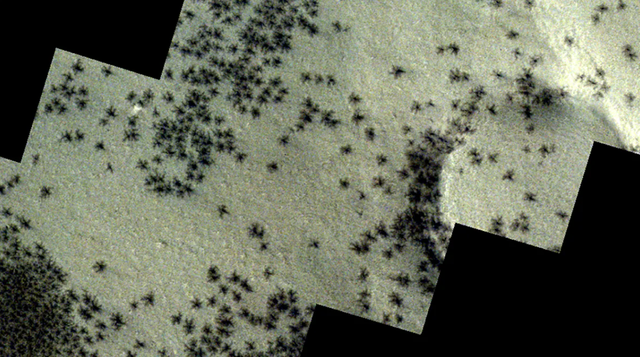
NASA PHOTO
NEWSLINE PAPER,-
The European Space Agency's (ESA) ExoMars Trace Gas Orbiter satellite has discovered a strange structure they call the "martian spider mark".
The image was taken from the south pole region of the Red Planet, showing a feature that looks like a giant spider on the planet's surface. But, of course, it's not the original spider, the feature was created in the ice as winter goes to spring on Mars.
"This small, dark feature is formed when spring sunlight shines the carbon dioxide layer stored during the dark winter months," ESA explains.
"Sunlight causes the carbon dioxide ice at the bottom of the layer to turn into gas, then build up and break the ice sheets on it. The gas explodes in the spring on Mars, dragging dark material to the surface over time and destroying the ice layer as thick as a meter."
The three gases come out, pushing dust and sand up, creating giant fountains and then falling back to Mars. As they sink, they create dark spots as seen in the picture, between 45 meters and 1 kilometer wide. In other words, patterns like spiders are actually a combination of dust and cracks in the ice.
The phenomenon of seeing familiar patterns on one object is called a pareidolia. Pareidolia is a psychological phenomenon involving vague and random stimuli—often an image or voice—which are considered important. Pareidolia comes from the combination of two ancient Greek words, 'para' meaning something wrong and 'eidolon' meaning image or form.
Pareidolia is a form of apophenia, a tendency to see relationships or patterns in unrelated or random things, such as objects or ideas.
Carl Sagan explains in his book "The Demon-Haunted World: Science as a Candle in the Dark," the ability to identify threats is crucial to our survival.
Ancient humans will escape when they see patterns like lions hiding in bushes. Those who can't see the pattern of lions will die. And even if the pattern in the bush that we see is not a lion, but a stone, yes, it's okay; the ancient manuisa can still survive and inherit the genes to the next generation.
"Our brains are constantly trying to understand the outside world. One way the brain achieves this goal is by detecting and studying patterns that are basically statistical regularities in the environment because these patters help the brain decide how to react or behave in order to survive," said Dr. Jess Taubert of the University of Queensland, quoted by IFLScience.
What ESA found on Mars makes our brains see patterns that are similar to spiders, this is part of the evolution that our ancestors pursued in the past. However, the ability to identify this pattern also sometimes leads to misinterpretation when looking at random images or light pattern that resembles faces or unknown objects.
(Newsline Paper Teams)
